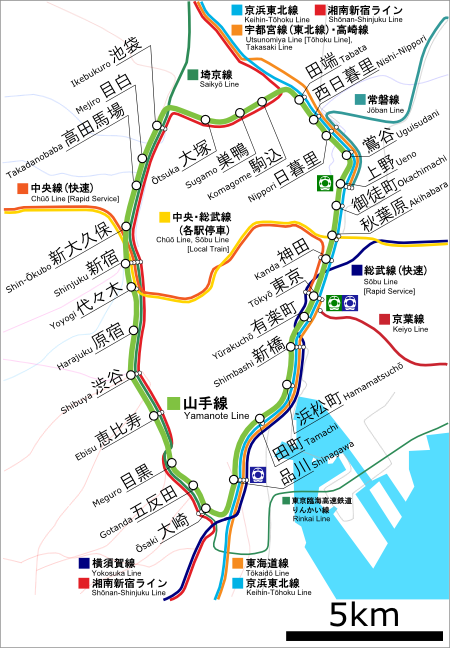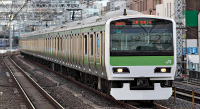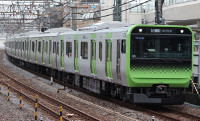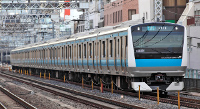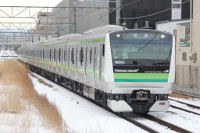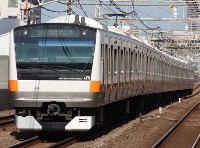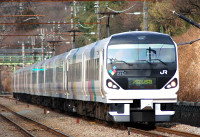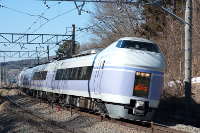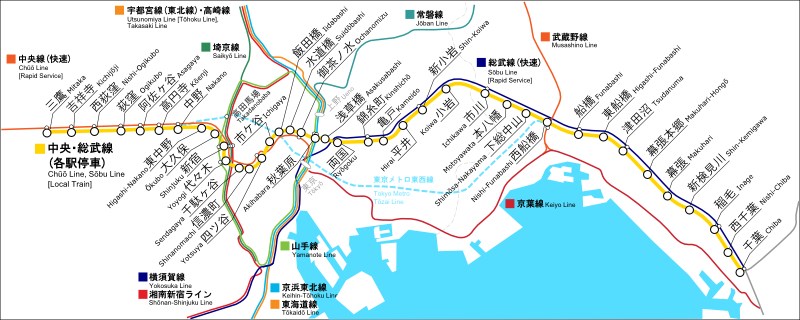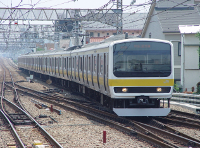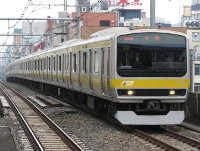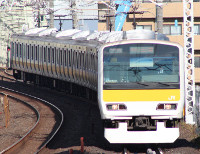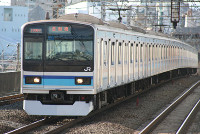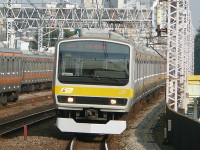JR East Lines
This is the page for all JR East Lines
- Yamanote Line
- Keihin-Tohoku Line
- Chuo Line Rapid
- Chuo-Sobu Line
- Saikyo Line
- Keiyo Line
- Yokohama Line
- Musashino Line
- Sobu Line Rapid
- Nambu Line
- Tokaido Main Line
- Yokosoka Line
- Nikko Line
Yamanote Line
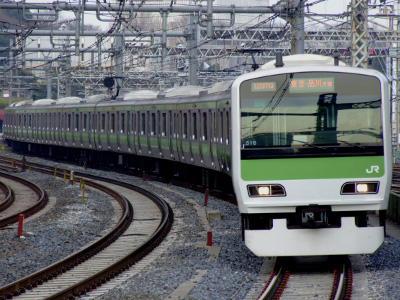
JR Yamanote Line E231 serie 500 for Tokyo and Shinagawa. (the clockwise line)
TypeHeavy Rail
LocaleTokyo
TerminiShinagawa (loop) Stations29 Daily ridership3,725,247 (daily, 2010)
OwnerJR East
DepotsTokyo General Rolling Stock Centre (near Ōsaki Station)
Rolling StockJR East E231-500 series, JR East E235 Series
No. of Tracks2
Track Gauge1,067 mm (3 ft 6 in)
Electrification1,500 V DC overhead catenary
Operating Speed90 km/h (55 mph)
The Yamanote Line (山手線 Yamanote-sen) is a railway loop line in Tokyo, Japan, operated by East Japan Railway Company (JR East). It is one of Tokyo's busiest and most important lines, connecting most of Tokyo's major stations and urban centres, including Marunouchi, the Yūrakuchō/Ginza area, Shinagawa, Shibuya, Shinjuku, Ikebukuro and Ueno, with all but two of its 29 stations connecting to other railway or underground (subway) lines.
As an official line name, "Yamanote Line" indicates the tracks between Shinagawa and Tabata that are used by local trains on their own tracks as well as the parallel Yamanote Freight Line which is used by Saikyō Line and Shōnan-Shinjuku Line trains, some limited express services, and freight trains. However, in everyday usage the "Yamanote Line" refers to the entire 34.5 km loop line served by local trains.
Service Outling
Trains run from 04:26 to 01:18 the next day at intervals as short as 2.5 minutes during peak periods and four minutes at other times. A complete loop takes 59 to 65 minutes. All trains stop at each station. Trains are put into and taken out of service at Ōsaki (which for timetabling purposes is the line's start and terminus) and sometimes Ikebukuro. Certain trains also start from Tamachi in the mornings and end at Shinagawa in the evenings. Trains which run clockwise are known as sotomawari (外回り, "outer circle") and those counter-clockwise as uchi-mawari (内回り, "inner circle"). (Trains travel on the left in Japan, as with road traffic.)
The line also acts as a fare zone destination for JR tickets from locations outside Tokyo, permitting travel to any JR station on or within the loop. This refers to stations on the Yamanote Line as well as the Chūō-Sōbu Line between Sendagaya and Ochanomizu.
The line colour used on all rolling stock, station signs and diagrams is JNR Yellow Green No.6 (■, Munsell code 7.5GY 6.5/7.8), known in Japanese as "Japanese Bush Warbler green" (ウグイス色 uguisu-iro).
Ridership
An estimated 3.68 million passengers ride every day on Tokyo's Yamanote Line, with its 29 stations. For comparison, the New York City Subway carries 5.08 million passengers per day on 26 lines serving 468 stations, and the London Underground carries 3.36 million passengers per day on 12 lines serving 275 stations.
Name
"Yamanote" literally refers to inland, hillier districts or foothills (as distinct from areas close to the sea). In Tokyo, "Yamanote" lies along the western side of the Yamanote Line loop. The word consists of the Japanese morphemes yama, meaning 'mountain', the genitive suffix no, and te, meaning 'hand', thus literally translating as "mountain's hand", analogous to the English term "foothills".
Yamanote-sen is officially written in Japanese without the kana no (の、ノ), which makes its pronunciation ambiguous in print. The characters 山手 may also be pronounced yamate, as in Yamate-dōri (Yamate Street), which runs parallel to the west side of the Yamanote Line. The Seishin-Yamate Line in Kobe and the Yamate area of Yokohama also use this pronunciation.
After World War II, SCAP ordered all train placards to be romanized, and the Yamanote Line was romanized as "Yamate Line". It was thus alternatively known as "Yamanote" and "Yamate" until 1971, when the Japanese National Railways changed the pronunciation back to "Yamanote." Some older people still refer to the line as the "Yamate Line".
History
The predecessor of the present-day Yamanote Line was opened on 1 March 1885 by the Nippon Railway Company, operating between Shinagawa Station in the south and Akabane Station in the north. The top part of the loop between Ikebukuro and Tabata (a distance of 3.3 km) opened on 1 April 1903, and both lines were merged to become the Yamanote Line on 12 October 1909.
The line was electrified in 1909, the same year the Osaki - Shinagawa section was double-tracked, with the loop completed in 1925 with the opening of the double track, electrified section between Kanda and Ueno on 1 November, providing a north-south link via Tokyo Station through the city's business centre. A parallel freight line, also completed in 1925, ran along the inner side of the loop between Shinagawa and Tabata.
During the prewar era, the Ministry of Railways did not issue permits to private suburban railway companies for new lines to cross the Yamanote Line from their terminal stations to the central districts of Tokyo, forcing the companies to terminate services at stations on the line. This policy led to the development of new urban centers (新都心、副都心 shintoshin, fukutoshin) around major transfer points on the Yamanote Line, most notably at Shinjuku and Ikebukuro (which are now the two busiest passenger railway stations in the world).
The contemporary Yamanote Line came into being on 19 November 1956 when it was separated from the Keihin-Tōhoku Line and given its own set of tracks along the eastern side of the loop between Shinagawa and Tabata. However, Yamanote Line trains continued to periodically use the Keihin-Tōhoku tracks, particularly on holidays and during off-peak hours, until rapid service trains were introduced on the Keihin-Tōhoku Line in 1988.
A major explosion on the Yamanote Freight Line in Shinjuku in 1967 led to the diversion of freight traffic to the more distant Musashino Line. To address severe undercapacity, the freight line was repurposed for use by Saikyo Line and Shōnan-Shinjuku Line trains, as well as certain limited express trains such as the Narita Express and some liner services. Likewise, there are currently plans to connect the Tohoku Main Line and Joban Line to the Tokaido Main Line via a new Ueno-Tokyo Line link to provide further relief on the busiest portion of the Yamanote Line today, the southbound segment between Ueno and Okachimachi.
Automatic train control (ATC) was introduced from 6 December 1981, and digital ATC (D-ATC) was introduced from 30 July 2006.
Station List
Here is the station list of the Yamanote Line clockwise from Tokyo (for transfers to other lines look at the page of the station).
Stations indicated with a | trains wont stop.
Stations indicated with a ● all trains stop.
Stations indicated with a ◆ trains only stop on weekends and national holidays.
Stations indicated with a ∥ trains do not run over that section of track.
Tokyo●
Kanda●
Akihabara●
Okachimachi●
Ueno●
Uguisudani●
Nippori●
Nishi-Nippori●
Tabata●
Komagome●
Sugamo●
Otsuka●
Ikebukuro●
Mejiro●
Takadanobaba●
Shin-Okubo●
Shinjuku●
Yoyogi●
Harajuku●
Shibuya●
Ebisu●
Meguro●
Gotanda●
Osaki●
Shinagawa●
Tamachi●
Hamamatsucho●
Shimbashi●
Yurakucho●
Current Rolling Stock
The line's services are operated exclusively by a fleet of 52 11-car E231-500 series EMUs, which were phased in from April 21, 2002. These trains originally each included two "six-door cars" with six pairs of doors per side and bench seats that were folded up to provide standing room only during the morning peak until 10 a.m. From February 22, 2010, the seats were no longer folded up during the morning peak, and all trains were standardized with newly built four-door cars by 31 August 2011. This was due to reduced congestion on the line as well as preparation for the installation of platform doors on all stations by 2017.
The E231 series supports a new type of traffic control system, called digital Automatic Train Control (D-ATC), which will help reduce one round trip to a very short 58 minutes. The series also has a more modern design and has two 15-inch LCD monitors above each door, one of which is used for displaying silent commercials, news and weather; and another which is used for displaying information on the next stop (in both Japanese and English) along with notification of delays on Shinkansen and other railway lines in the greater Tokyo area. The E231-500 series trains are based at Tokyo General Rolling Stock Centre near Ōsaki Station.
New E235 series 11-car EMUs are scheduled to be phased in on the line from autumn 2015 replacing the E231 series by the 2020 Summer Olympics.
JR East E231-500 series
JR East E235 Series
Future Developments
In January 2012, it was announced that a new station would be built on the Yamanote Line and Keihin-Tohoku Line between Shinagawa and Tamachi stations, becoming the first new station on the line since Nishi-Nippori was built in 1971. The distance between Shinagawa and Tamachi stations is 2.2 km, making it the longest stretch of track between stations on the Yamanote Line. The new station will be constructed on top of the current 20-hectare railyard which is undergoing rationalization and redevelopment by JR East; it would be roughly parallel to the existing Sengakuji Station on the Toei Asakusa and Keikyu Main lines. The Yamanote Line and the Keihin Tohoku Line tracks will be moved slightly to the east to be aligned closer to the Tokaido Shinkansen tracks. The area on the west side of the yard made available will be redeveloped with high-rise office buildings, creating an international business center with good connections to the Shinkansen and Haneda Airport. The new station is scheduled to open in time for the 2020 Summer Olympics to be held in Tokyo.
Keihin-Tōhoku Line
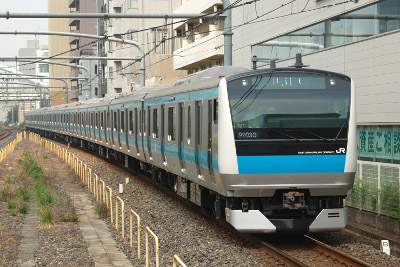
JR Keihin-Tōhoku Line E233 serie 1000 Arriving at Saitama Shintoshin.
TypeHeavy Rail
LocaleTokyo, Saitama, Kanagawa prefectures
TerminiŌmiya, Yokohama Stations35
OwnerJR East
Rolling StockE233-1000 series
Track Gauge1,067 mm (3 ft 6 in)
Electrification1,500 V DC overhead catenary
Operating Speed90 km/h (55 mph)
The Keihin-Tōhoku Line (京浜東北線 Keihin-tōhoku-sen), is a railway line in Japan which connects the cities of Saitama, Kawaguchi, Tokyo, Kawasaki, and Yokohama. It is part of the East Japan Railway Company (JR East) network. The line's name is derived from the characters for Tokyo (東京), Yokohama (横浜) and the Tōhoku Main Line (東北本線). The Keihin-Tōhoku Line officially follows portions of the Tōhoku Main Line and Tōkaidō Main Line. Between Ueno and Akabane stations the Keihin-Tohoku and Tohoku Main lines are physically separate and thus alternate routes.
All Keihin-Tōhoku Line trains have through service onto the Negishi Line between Yokohama and Ōfuna stations. As a result, the entire service between Ōmiya and Ōfuna is typically referred to as the Keihin-Tōhoku—Negishi Line (京浜東北線・根岸線) on system maps and in-train station guides. Keihin-Tōhoku Line—Negishi Line trains are recognizable by their light blue stripe (the line's color on maps is also light blue).
Service Outling
Trains run every 2–3 minutes at peak hours, every 5 minutes during the daytime, and less frequently the rest of the time. In most instances, these trains are classified as "Local" (各駅停車 Kakueki-Teisha), stopping at all stations en route. However, during the daytime, trains are classified as "Rapid" (快速 kaisoku). These rapid trains skip some stations in central Tokyo, where it runs parallel to the Yamanote Line.
Accidents
At around 01:11 in the morning of 23 February 2014, an empty stock train operating from Sakuragicho to Kamata hit a track maintenance vehicle on the track close to Kawasaki Station. The first two cars of the 10-car E233 series train derailed, with the first car ending up on its side. The train was carrying no passengers, and the driver and conductor escaped with minor injuries.
History
The line opened on 20 December 1914 as an electrified passenger line connecting Shinagawa Station in Tokyo with Takashimacho Station in Yokohama. (The latter station was renamed Yokohama Station in August 1915, when the former Yokohama Station was renamed Sakuragicho Station). It was originally called the Tokaido Electric Line (東海道電車線) and was subsequently renamed the Keihin Line (京浜線). From 30 December 1915, services were extended south to the new Sakuragicho Station.
The Keihin Line service was extended north via the Tohoku Main Line to Akabane Station in February 1928, and to Ōmiya Station in September 1932.
The Keihin Line initially had third-class and second-class cars, analogous to today's ordinary cars and Green Cars respectively. Second-class service ended in 1938 in order to accommodate special military cars during World War II. The military seating was converted to seating for women and children after the war, and back to ordinary seating in 1973 amid overcrowding concerns: second-class service was briefly restored in the 1950s but abandoned shortly thereafter.
From November 1956, the Keihin-Tohoku Line was physically separated from the Yamanote Line between Tamachi and Tabata, allowing more frequent service. Through service with the Negishi Line began on 19 May 1964. 10-car trains (103 series) began operating from 1 April 1966.
Limited-stop "Rapid" services were introduced in 1988 to further ease congestion along the Yamanote Line corridor. From 14 March 2015, all rapid services began serving Kanda Station. Additionally, rapid services began serving Okachimachi Station on weekends and national holidays only.
Station List
Here is the station list of the Keihin-Tōhoku Line from Ōmiya (for transfers to other lines look at the page of the station).
Stations indicated with a | trains wont stop.
Stations indicated with a ● all trains stop.
Stations indicated with a ◆ trains only stop on weekends and national holidays.
Stations indicated with a ∥ trains do not run over that section of track.
Omiya●●
Saitama-Shintoshin●●
Yono●●
Kita-Urawa●●
Urawa●●
Minami-Urawa●●
Warabi●●
Nishi-Kawaguchi●●
Kawaguchi●●
Akabane●●
Higashi-Jujo●●
Oji●●
Kami-Nakazato●●
Tabata●●
Nishi-Nippori●|
Nippori●|
Uguisudani●|
Ueno●●
Okachimachi●◆
Akihabara●●
Kanda●●
Tokyo●●
Yurakucho●|
Shimbashi●|
Hamamatsucho●●
Tamachi●●
Shinagawa●●
Oimachi●●
Omori●●
Kamata●●
Kawasaki●●
Tsurumi●●
Shin-Koyasu●●
Higashi-Kanagawa●●
Yokohama●●
Through service via the Negishi Line to Sakuragichō, Isogo, and Ōfuna
Current Rolling Stock
As of January 2010, all Keihin-Tohoku Line services are formed of E233-1000 series 10-car electrical multiple unit (EMU) trains. These were phased in from December 2007, and replaced the previous 209 series 10-car EMUs by 24 January 2010. All Keihin-Tohoku Line rolling stock is based at Urawa Depot. Yokohama Line E233-6000 series 8-car EMUs also operate on through services over the Keihin-Tohoku Line between Higashi-Kanagawa and Ofuna stations.
Keihin-Tohoku Line & Negishi Line services
JR East E233-1000 series 10-car EMUs (sky blue stripe) (from December 2007)
Yokohama Line through services
JR East E233-6000 series 8-car EMUs (light/dark green stripe) (from February 2014)
Future Developments
In January 2012, it was announced that a new station would be built on the Yamanote Line and Keihin-Tohoku Line between Shinagawa and Tamachi stations, becoming the first new station on the line since Nishi-Nippori was built in 1971. The distance between Shinagawa and Tamachi stations is 2.2 km, making it the longest stretch of track between stations on the Yamanote Line. The new station will be constructed on top of the current 20-hectare railyard which is undergoing rationalization and redevelopment by JR East; it would be roughly parallel to the existing Sengakuji Station on the Toei Asakusa and Keikyu Main lines. The Yamanote Line and the Keihin Tohoku Line tracks will be moved slightly to the east to be aligned closer to the Tokaido Shinkansen tracks. The area on the west side of the yard made available will be redeveloped with high-rise office buildings, creating an international business center with good connections to the Shinkansen and Haneda Airport. The new station is scheduled to open in time for the 2020 Summer Olympics to be held in Tokyo.
Chūō Line Rapid
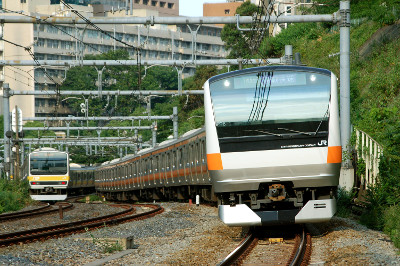
A Chūō Line (Rapid) E233 series (right) and A Chūō-Sōbu Line E231 series (June 2007)
TypeHeavy Rail
LocaleTokyo
TerminiTokyo, Takao Stations24
Track Gauge1,067 mm (3 ft 6 in)
Electrification1,500 V DC overhead catenary
Operating Speed100 km/h (60 mph)
The Chūō Line (Rapid) (中央線快速 Chūō-sen kaisoku) is the name given to rapid services on the eastern section of the Chūō Main Line operated by the East Japan Railway Company (JR East) between Tokyo and Takao stations.
Services
Although the Chūō Line (Rapid) designation only refers to the section between Tokyo and Takao stations, many trains continue on past Takao to Ōtsuki. These include both limited express and various special rapid services. In addition, Chūō Line (Rapid) trains do not stop at some stations between Ochanomizu and Nakano stations.
The Chūō Line (Rapid) uses the two express tracks on the four-track section between Ochanomizu and Mitaka stations. Past Mitaka, trains use both tracks on the remaining double-track section. Since the express tracks do not have platforms at several stations in central Tokyo, even the slowest services of the Chūō Line (Rapid) skip such stations and are therefore called "Rapid" (快速). In addition to the basic type of "Rapid", there are some variations of the service types with fewer stops.
Rapid
This service is the most common on the Chūō Line (Rapid) route; they stop at all stations west of Nakano. After Nakano, it stops at Shinjuku, Yotsuya, Ochanomizu, and Kanda stations before arrival in Tōkyō Terminal. On weekends and holidays, trains do not stop at Asagaya, Kōenji, or Nishi-Ogikubo stations. The signature color of the rolling stock, station signs and line diagrams is orange (■).
Chūō Special Rapid • Ōme Special Rapid
Four services per hour in off-peak hours make limited stops between Tokyo and Tachikawa, and stop at all stations west of Tachikawa. Chūō Special Rapid stays on the Chūō Main Line to Takao and Ōtsuki while Ōme Special Rapid spurs to the Ōme Line. The service's signature color on service diagrams is blue (■) for Chūō Special Rapid and green (■) for Ōme Special Rapid. This service stops at Mitaka and Kokubunji between Nakano and Tachikawa stations. It continues from Nakano as a rapid service.
Commuter Rapid
Commuter Rapid service operates weekday evening. The service's signature color on service diagrams is purple (■). It stops at Ogikubo and Kichijōji in addition to the stops of Chūō Special Rapid.
Commuter Special Rapid
Weekday morning services for Tokyo; two from Ōtsuki, two from Ōme and one from Takao. It stops at all stations until Takao, Hachiōji, Tachikawa, Kokubunji, and Shinjuku and continues as a rapid service from Shinjuku. Services from Ōme from the Ōme Line stops at all stations on the Ōme Line. The service's signature color on service diagrams is pink (■).
Chūō/Ōme Liners
The Chūō Liner and Ōme Liner services run on weekday peak periods only. There is one Chūō Liner from Takao for Tokyo in the morning and six in the evenings from Tokyo for Takao and Hachioji and in the past terminating in Ōtsuki. The Ōme Liner has one service during the morning from Ōme and two in the evening from Tokyo. Unlike other rapid services, the Chūō/Ōme Liners require the purchase of a liner ticket in addition to the base fare; all seats are unreserved, but the number of liner tickets sold is limited to the number of seats available. Liner services are provided by E257 series 11-car or 9-car EMUs (introduced in July 2002) and E351 series 12-car EMUs (introduced in March 2008).
Chūō Liners stop at: Tokyo - Shinjuku - Tachikawa - Hachiōji - (Takao)
Ōme Liners stops at: Tokyo - Shinjuku - Tachikawa - Haijima - Kabe - Ōme
History
Most of the route of the Chūō Line (Rapid) was built by the Kōbu Railway and later acquired by the Japanese Government Railways in 1906.
Operation of electric multiple unit (EMU) trains on the Chūō Main Line began in 1904. By 1930, the EMU service had reached Tokyo to the east and Asakawa (now Takao) to the west. In 1933, two tracks were added to the existing double-tracked section between Ochanomizu and Iidamachi stations (later closed) to complete the four-track line between Ochanomizu and Nakano. On these additional tracks, express trains (急行電車 kyūkō densha?), which skipped all stations except Yotsuya and Shinjuku, were introduced the same year. The express service was renamed "Rapid" (快速 kaisoku?) service in March 1961.
Initially, the operation of express/rapid services was limited to weekday peak periods only. Express service began on weekends on March 5, 1944; daytime non-peak operation began on November 9, 1959, but it was limited to weekdays only until April 28, 1966.
Manseibashi Station, located between Kanda and Ochanomizu, was closed in 1943. On the section east of Takao, only Nishi-Kokubunji Station (opened in 1973) and Nishi-Hachiōji Station (opened in 1939) were opened after the start of rapid services.
- August 20, 1979: 201 series EMUs introduced
- March 16, 1991: Ohayō Liner Takao/Ōme and Home Liner Takao/Ōme begin operation
- April 10, 1993: Kokubunji Station added to Ōme Special Rapid stops; Commuter Special Rapid begins operation
- December 1, 1997: Chūō Main Line-bound 115 series EMUs no longer service Shinjuku Station
- October 5, 2005: Women-only cars introduced
- December 26, 2006: E233 series EMUs introduced
Station List
Here is the station list of the Chūō Line Rapid Serivce from Tōkyō (for transfers to other lines look at the page of the station).
Stations indicated with a | trains wont stop.
Stations indicated with a ● all trains stop.
Stations indicated with a ◆ trains only stop on weekends and national holidays.
Stations indicated with a ∥ trains do not run over that section of track.
R = Rapid
CR = Commuter Rapid
SR = Special Rapid (Chūō)
OSR = Ōme Special Rapid
CSR = Cummuter Special Rapid
CL = Chūō Liner
OL = Ōme Liner
Tokyo●●●●●●●
Kanda●●●●●||
Ochanomizu●●●●●||
Yotusuya●●●●●||
Shinjuku●●●●●●●
Nakano●●●●|||
Koenji◆||
||
||
Asagaya◆||
||
||
Ogikubo●●
||||| Nishi-Ogikubo◆||
||
||
Kichijoji●●||
|||
Mitaka●●●●
|||
Musashi-Sakai●||
||
||
Higashi-Koganei●||
||
||
Musashi-Koganei●||
||
||
Kokubunji●●●●●
||
Nishi-Kokubunji●||||||
Kunitachi●||||||
Tachikawa●●●●●●●
Hino●●●∥||∥
Toyoda●●●∥||∥
Hachioji●●●∥●●∥
Nishi-Hachioji●●●∥||∥
Takao●●●∥●●∥
Through service via the Negishi Line to Sakuragichō, Isogo, and Ōfuna
Current Rolling Stock
Rapid・Commuter Special Rapid・Chūō Special Rapid・Ōme Special Rapid・Commuter Rapid
JR East E233-0 Series (from December 2006)
Chūō Liner / Ōme Liner
JR East E257 Series (from July 2002)
JR East E351 Series (from March 15, 2008)
Future developments
In February 2015, JR East announced plans to introduce Green (first class) cars on Chuo Line (Rapid) and Ome Line services from fiscal 2020. This will involve adding two bilevel Green cars to 10-car E233 series EMU sets, forming 12-car sets. Work will be involved in lengthening station platforms and depot facilities to handle the longer trains.
High suicide rate
The Chuo Rapid Line is known for a high number of suicides, primarily due to the high speed at which some trains pass through stations on the line.
Chūō-Sōbu Line
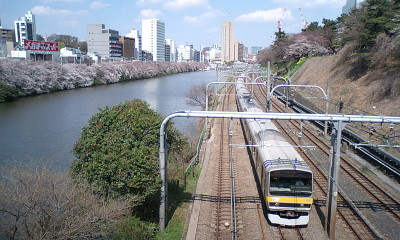
An E231 series EMU on the Chūō-Sōbu Line in central Tokyo, March 2008
LocaleTokyo, Chiba prefectures
TerminiMitaka, Chiba Stations39
OwnerJR East
Rolling Stock209-500 series, E231 series, E231-500 series, E231-800 series
Track Gauge1,067 mm (3 ft 6 in)
Electrification1,500 V DC overhead catenary
The Chūō-Sōbu Line (中央・総武緩行線 Chūō-Sōbu-kankō-sen) is a railway line located in Tokyo and Chiba Prefecture, Japan. Part of the East Japan Railway Company (JR East) network, it operates on separate tracks along the right-of-way of the Chūō Main Line (Chūō Line (Rapid)) and Sōbu Main Line (Sōbu Line (Rapid)), providing service between Mitaka Station in the cities of Mitaka and Musashino and Chiba Station in Chiba.
The term Kankō (緩行 lit. "slow run") distinguishes local trains on the Chūō-Sōbu line from rapid service trains running on the Chūō Main Line between Mitaka and Ochanomizu and on the Sōbu Main Line between Kinshichō and Chiba.
History
Women-only cars, designed to prevent chikan, were introduced on this line during morning peak periods starting on November 20, 2006.
Station List
Except for certain limited express and seasonal trains, all local service trains stop at every station.
Some Tokyo Metro Tōzai Line trains have through service on the Nishi-Funabashi – Tsudanuma (mornings/evenings only) and Nakano – Mitaka sections.
For information on limited express trains that make stops on the Chūō-Sōbu Line between Kinshicho and Ochanomizu.
Here is the station list of the Chūō Line Rapid Serivce from Tōkyō (for transfers to other lines look at the page of the station).
Stations indicated with a | trains wont stop.
Stations indicated with a ● all trains stop.
Stations indicated with a ◆ trains only stop on weekends and national holidays.
Stations indicated with a ∥ trains do not run over that section of track.
Chiba●
Nishi-Chiba●
Inage●
Shin-Kemigawa●
Makuhari●
Makuhari-Hongō●
Tsudanuma●
Higashi-Funabashi●
Funabashi●
Nishi-Funabashi●
Shimōsa-Nakayama●
Motoyawata●
Ichikawa●
Koiwa●
Shin-Koiwa●
Hirai●
Kameido●
Kinshichō●
Ryōgoku●
Asakusabashi●
Ochanomizu●
Suidōbashi●
Īdabashi●
Ichigaya●
Yotsuya●
Shinanomachi●
Sendagaya●
Yoyogi●
Shinjuku●
Ōkubo●
Higashi-Nakano●
Nakano●
Kōenji●
Asagaya●
Ogikubo●
Nishi-Ogikubo●
Kichijōji●
Mitaka●
Current Rolling Stock
Trains used on the Chūō-Sōbu Line are based at Mitaka Depot.
JR East 209-500 series 10-car EMUs (yellow stripe) (since December 1998)
JR East E231-0 series 10-car EMUs (yellow stripe) (since February 2000)
JR East E231-500 series 10-car EMU (yellow stripe) (since 1 December 2014)
JR East E231-800 series 10-car EMUs (light blue stripe) (since 1 May 2003)
JR East E231-900 series 10-car EMU (yellow stripe) (since 27 March 1999 as 209-950 series)
Saikyō Line
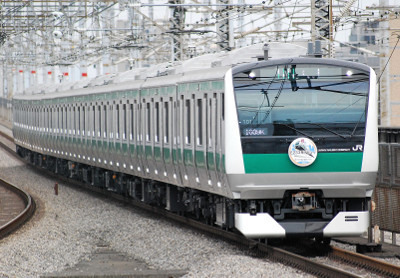
Saikyō Line E233 series EMU set 101 approaching Yonohommachi Station, July 2013
TypeCommuter rail
LocaleTokyo, Saitama prefectures
TerminiŌsaki, Ōmiya Stations19
OwnerJR East
Depot(s)Kawagoe (Minami-Furuya)
Rolling Stock205 series, E233-7000 series, TWR 70-000 series EMUs
Track Gauge1,067 mm (3 ft 6 in)
Electrification1,500 V DC overhead catenary
Operation Speed100 km/h (60 mph)
The Saikyō Line (埼京線 Saikyō-sen) is a Japanese railway line operated by the East Japan Railway Company (JR East). It connects Ōsaki Station in Shinagawa, Tokyo, and Ōmiya Station in Saitama Prefecture. The line's name is an abbreviation of the two areas the line connects: Saitama (埼玉) and Tōkyō (東京).
At the northern end of the line, some trains continue beyond Ōmiya as far as Kawagoe on the Kawagoe Line; at the southern end of the line, many Saikyō Line trains continue onward beyond Ōsaki to Shin-Kiba on the Rinkai Line (operated by Tokyo Waterfront Area Rapid Transit). Beside the link that connects the Saikyō and Rinkai lines is the JR East Tokyo General Rolling Stock Centre that stores the rolling stock for the Yamanote Line and other types of rolling stock.
Basic Data
- Operator: East Japan Railway Company (JR East) (Services and tracks)
- Ōsaki – Ikebukuro – Akabane – Musashi-Urawa – Ōmiya: 36.9 km (22.9 mi)
- Ōsaki – Ikebukuro: 13.4 km (8.3 mi) (Yamanote Line freight line)
- Ikebukuro – Akabane: 5.5 km (3.4 mi) (Akabane Line)
- Akabane – Musashi-Urawa – Ōmiya: 18.0 km (11.2 mi) (Tōhoku Main Line branch)
- Ōsaki – Ikebukuro – Akabane – Musashi-Urawa – Ōmiya: 36.9 km (22.9 mi)
- Double-tracking: Entire line
- Railway signalling:
- Ōsaki – Ikebukuro: Automatic Block System
- Ikebukuro – Ōmiya: Automatic Train Control
- Maximum speed:
- Akabane – Ōmiya: 100 km/h (62 mph)
- Itabashi – Akabane: 90 km/h (56 mph)
- All other sections: 95 km/h (59 mph)
Route
The line runs parallel to the Yamanote Line between Ōsaki and Ikebukuro, where it is formally called the Yamanote Freight Line (山手貨物線), and as an alternate route to the Tōhoku Main Line between Akabane and Ōmiya, where it is unofficially called the Tohoku Honsen Secondary Line (東北本線支線). The portion between Ikebukuro and Akabane is officially known as the Akabane Line (赤羽線). For most purposes, JR refers to all of these as part of the "Saikyō Line" when being used for Saikyō Line services.
Service
There are three types of trains on the Saikyō Line: all-stations "Local" (各駅停車 Kakueki-Teisha), "Rapid" (快速 kaisoku), and "Commuter Rapid" (通勤快速 tsūkin kaisoku). Between Akabane and Ōmiya, Rapid trains stop only at Toda-Kōen, Musashi-Urawa and Yonohommachi, while Commuter Rapid trains, which run during rush hours, stop only at Musashi-Urawa. Between Akabane and Ikebukuro, as well as on the Kawagoe and Rinkai lines, all trains stop at all stations. Between Ikebukuro and Osaki on the Yamanote Freight Line, all trains run limited-stop in both directions, with the Yamanote Line providing all-stations service.

